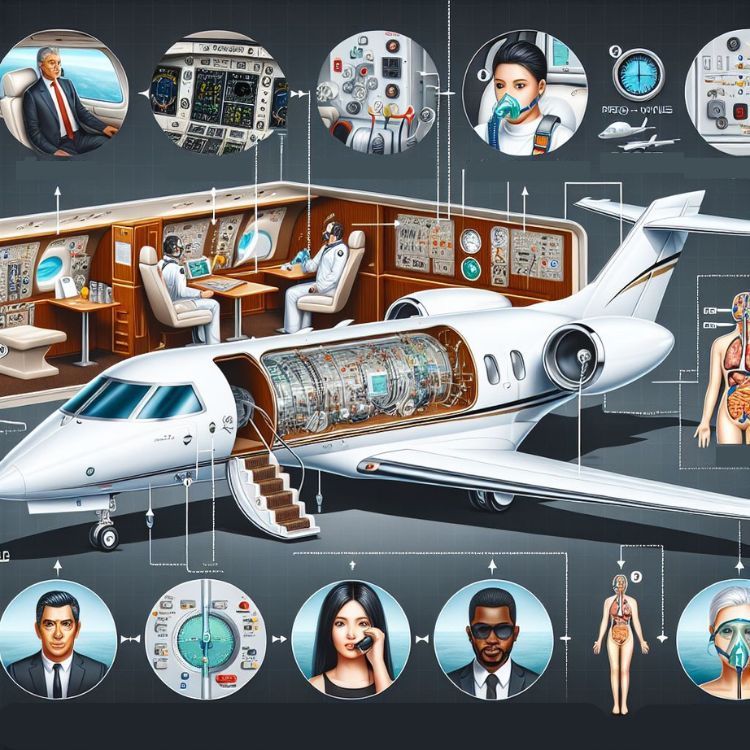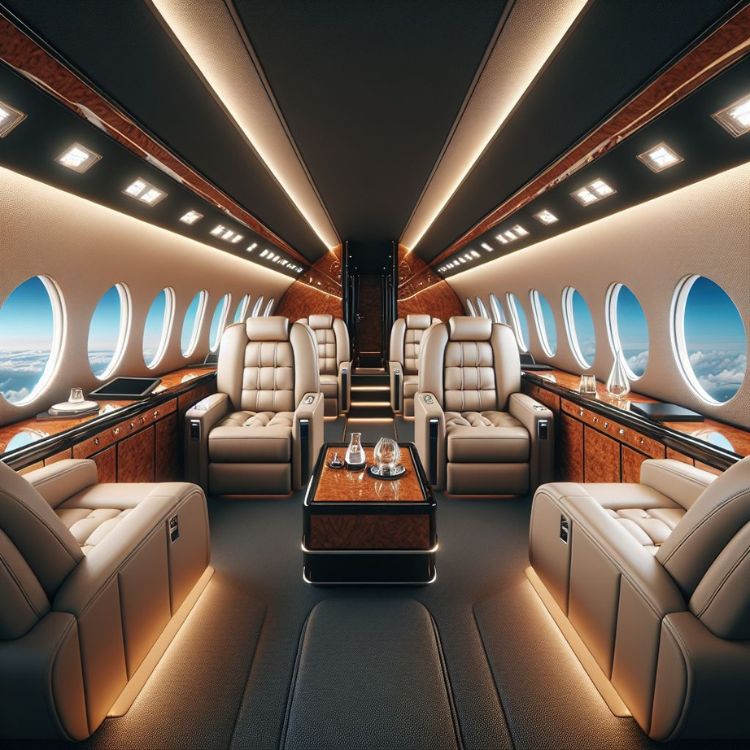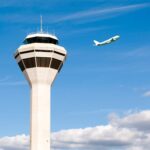
Key Takeaways – A Quick Guide
- Understanding how cabin pressure and oxygen levels are maintained is key to a comfortable private jet experience.
- At cruising altitudes, the air is thinner, making pressurization systems crucial for passenger and crew safety.
- Private jets use advanced pressurization systems to maintain a cabin altitude much lower than the actual flying altitude.
- Oxygen masks and supplemental oxygen are essential safety features, especially in the unlikely event of cabin depressurization.
- Regular checks and maintenance of the cabin environment systems ensure the safety and comfort of everyone on board.

The Essence of Cabin Environment Control
When you board a private jet, you’re entering a carefully controlled micro-environment. As we ascend into the skies, the air outside becomes too thin to breathe. To keep you safe and comfortable, the cabin must simulate the conditions you’re used to on the ground. That’s where pressurization comes in. It’s a hidden hero in aviation, responsible for making high-altitude travel possible.
Oxygen Levels at High Altitude
Imagine you’re on top of a tall mountain. The air is cool, the view is spectacular, but you might find yourself short of breath. That’s because the higher you go, the less oxygen there is in the air. It’s the same principle when flying. At cruising altitude, the air outside the jet is too thin to support human life. This is why maintaining proper oxygen levels inside the cabin is not just a matter of comfort, but a strict safety requirement.
Private Jet Pressurization Mechanisms
So, how do private jets keep cabin conditions so cozy? They have a pressurization system that pumps air into the cabin, creating a pressure similar to what you’d experience at a much lower altitude. This process is continuous and automatic, ensuring that the environment inside the jet remains steady and pleasant throughout your journey.
Now, let’s dive into the specifics of how these systems work to provide you with a breathable and comfortable cabin environment.
Oxygen Supply: Vital for Health at High Altitudes
Onboard a private jet, the oxygen you breathe comes from two sources. The air that’s compressed and pumped into the cabin by the engines, and the supplemental oxygen stored for emergencies. Both systems are meticulously designed to meet your body’s needs, even above the clouds.
How Oxygen is Provided Onboard
The primary source of oxygen comes from the air that’s drawn into the jet engines. Here, it’s compressed, which heats it up. The air is then cooled and led into the cabin, ensuring you have plenty of oxygen to breathe. But that’s not all. For safety, private jets also carry supplemental oxygen. This is for use if the pressurization system fails or if a passenger needs extra oxygen due to medical reasons.
Now, you might wonder, how do we know the right amount of oxygen to provide? That’s where the concept of ‘cabin altitude’ comes into play.
Identifying the Right Oxygen Level for Your Flight
‘Cabin altitude’ refers to the equivalent altitude inside the aircraft. Even though the jet might be cruising at 40,000 feet, the pressurization system ensures the cabin altitude feels like it’s between 6,000 and 8,000 feet. This is the sweet spot where your body gets enough oxygen without the air feeling too heavy.
Let’s take a closer look at how cabin pressure contributes to your comfort and safety in the skies.
Identifying the Right Oxygen Level for Your Flight
- Check the ‘cabin altitude’ of your private jet, which should ideally be between 6,000 and 8,000 feet.
- Ensure the jet is equipped with a modern pressurization system that automatically adjusts the cabin pressure.
- If you have specific medical needs, inform the flight crew so they can make necessary adjustments or preparations.
To ensure your flight is as comfortable as possible, you’ll want to know the cabin altitude where the pressure is set. This information is often available from the flight crew or operator. A lower cabin altitude means more oxygen and a more comfortable experience, especially for those sensitive to altitude changes.
For those who might need additional oxygen, such as individuals with certain medical conditions, private jets can be equipped to cater to these needs. It’s important to communicate with your charter company or flight department ahead of time to make arrangements. They can provide supplemental oxygen or even adjust the cabin altitude to a lower setting for your comfort.
Remember, the goal is to feel as good when you land as when you took off. Adjusting the cabin environment to the right oxygen level plays a big part in achieving that.
Mastering Cabin Pressure: Comfort Above the Clouds
Imagine you’re inside a soda can flying high above the earth. The can is sealed tight to keep the pressure inside just right, ensuring the soda stays fizzy. That’s similar to how cabin pressure works in a private jet. It’s all about maintaining that perfect balance to ensure your comfort.
Cabin pressure is like an invisible comfort blanket, wrapping you in an environment that feels just right. In the pressurized cabin of a private jet, sophisticated systems work tirelessly to maintain this balance. They adjust the flow of air into and out of the cabin to simulate a lower altitude, keeping you cozy and comfortable.
But it’s not just about comfort. The pressure needs to be right to keep you healthy. Too much or too little pressure can have significant effects on your body. That’s why these systems are designed with precision and monitored throughout your flight.
As you enjoy the luxury and convenience of private air travel, you can rest assured that a lot of science and engineering is working behind the scenes to make your journey as pleasant as possible.
Understanding Pressurization Systems
These systems are marvels of engineering, combining mechanical, electronic, and aerodynamic principles to control the environment inside the jet. High-pressure air is taken from the engines and cooled before it enters the cabin. The amount of air entering and leaving the cabin is regulated by devices called outflow valves, ensuring a constant and comfortable cabin pressure.
The pressurization system is managed by a cabin pressure controller, a sophisticated piece of equipment that automates the entire process. It’s set to maintain the optimal cabin altitude, so you don’t have to worry about a thing.
If you’re curious about what’s happening during your flight, the flight crew can usually provide insights into the pressurization settings and how the system is performing. Don’t hesitate to ask; they’re there to ensure your flight experience is the best it can be.
And in the very rare event that the pressurization system fails, safety measures are in place to protect you. Oxygen masks will deploy, and the pilot will quickly descend to a safer, breathable altitude.
For example, on a recent Gulfstream G650 flight, the pressurization system maintained a cabin altitude of just 4,000 feet while cruising at 45,000 feet, offering an exceptionally comfortable experience for passengers accustomed to lower altitudes.
Maintaining Ideal Cabin Pressure
Maintaining the ideal cabin pressure is a dynamic process that adapts to the altitude of the jet. As the aircraft climbs, the pressure inside the cabin gradually increases until it reaches the preset cabin altitude. During descent, the process reverses, ensuring a smooth transition back to ground-level pressure.
To give you an idea of the care taken to maintain cabin pressure, consider this:
- The pressurization system is regularly checked before and after flights.
- Any irregularities in cabin pressure are immediately addressed by trained technicians.
- The flight crew monitors cabin pressure throughout the flight, ready to make adjustments as needed.
This attention to detail is what sets private jet travel apart. It’s about providing a seamless experience where the only thing you’ll notice is how relaxed you feel at every stage of your journey.
Effects on Your Well-Being: The Passenger Experience
It’s not just about getting from point A to point B. Your flight should leave you feeling refreshed and ready for whatever lies ahead. That’s why understanding and controlling the cabin environment is crucial. It has a direct impact on your well-being.
The Importance of Cabin Environment for Passenger Health
The air you breathe and the pressure surrounding you at altitude can affect everything from your energy levels to your ability to concentrate. In the cocoon of a private jet cabin, these factors are fine-tuned to ensure you arrive feeling your best. The right balance of oxygen and pressure reduces fatigue, minimizes the risk of jet lag, and helps prevent the discomfort that can come from flying.
How Pressurization Affects the Human Body
Our bodies are designed to live at sea level, where the air is densest. As we go higher, the pressure drops, and our bodies have to work harder to get the oxygen we need. The symptoms of being at a high altitude can range from mild headaches and dizziness to more serious conditions like hypoxia, where the body is starved of oxygen.
But in the well-regulated cabin of a private jet, these concerns are mitigated. The pressurization system ensures you’re getting the right amount of oxygen, and the comfortable cabin altitude keeps your body feeling like it’s in its natural environment.
So, sit back, relax, and enjoy the flight. Your private jet is equipped to take care of you, ensuring you step off the plane ready to take on the day.
Safety First: Ensuring a Secure Cabin Environment
When we talk about flying, safety is paramount. The same technology that keeps you comfortable in the air also ensures your safety. It’s a dual-purpose system that’s constantly checked and double-checked for reliability. Let’s break down how these systems are maintained and what features modern private jets have to safeguard your journey.
Regular Checks and Maintenance of Oxygen Systems
Before every flight, pilots and maintenance teams perform thorough checks of the pressurization and oxygen systems. It’s a rigorous process designed to catch any potential issues before they become problems. The checks include verifying the proper function of oxygen masks, ensuring there’s an adequate supply of supplemental oxygen, and confirming that all sensors and controls are operating correctly.
These checks are not just a pre-flight routine; they’re also carried out after the flight to ensure everything is ready for the next journey. It’s this level of attention to detail that provides peace of mind when you’re cruising at 40,000 feet.
Advanced Safety Features of Modern Private Jets
Modern private jets are equipped with the latest advancements in safety technology. From state-of-the-art air filtration systems to advanced cockpit alerts that notify pilots of any pressure fluctuations, these jets are designed to keep you safe. In the event of a pressurization issue, pilots are trained to descend to a lower, breathable altitude while deploying oxygen masks for passengers.
These safety features are discreet, often going unnoticed, which is exactly how it should be. You should be able to enjoy your flight without worrying about the systems that are working to protect you.
Frequently Asked Questions
How is the cabin pressure maintained in a private jet during flight?
The cabin pressure in a private jet is maintained by a pressurization system that controls the amount of compressed air that is pumped into the cabin. This system uses engine bleed air, which is cooled and then introduced into the cabin, to create a pressure equivalent to a lower altitude. The system is automated, constantly adjusting to maintain the preset ‘cabin altitude’ for optimal comfort and safety.
What happens if the cabin loses pressure?
If a private jet’s cabin loses pressure, several safety measures are immediately activated. Oxygen masks will deploy from the ceiling, allowing passengers to breathe supplemental oxygen. Meanwhile, the pilot will initiate an emergency descent to a lower altitude where the air is breathable. Modern jets are also equipped with alarms and sensors that alert the crew to any loss of cabin pressure, enabling a swift response.
How does the oxygen supply work in private jets?
The oxygen supply in private jets works on two fronts. Primarily, oxygen is provided by compressing and pumping air into the cabin. In addition, there are supplemental oxygen systems, which include tanks and masks, stored for emergencies. These systems are designed to engage automatically if the cabin pressure drops, or they can be deployed manually by the flight crew if needed.
Is cabin pressure and oxygen level the same in all private jets?
No, cabin pressure and oxygen levels can vary among different private jets. The specific systems and settings are determined by the aircraft’s design and its operational ceiling. However, all private jets are required to maintain cabin pressure and oxygen levels within safe limits, as regulated by aviation authorities. Operators can also adjust these settings to cater to the specific needs of their passengers.
Can passengers control their own oxygen levels during a private jet flight?
Passengers cannot directly control the oxygen levels, as the pressurization system is managed by the flight crew. However, if passengers have specific medical needs that require additional oxygen, arrangements can be made with the charter company or flight department to provide supplemental oxygen during the flight.
In conclusion, the cabin environment of a private jet is a complex and finely tuned space, designed for your safety and comfort. From the moment you step on board, advanced systems work to ensure the air you breathe and the pressure around you are just right. With regular maintenance, advanced safety features, and trained professionals at the helm, you can sit back, relax, and enjoy a seamless flight experience that leaves you feeling refreshed upon arrival.
Understanding the cabin environment on a private jet is crucial for a comfortable journey. The air pressure and oxygen levels are carefully regulated to ensure that passengers experience a smooth flight. It’s also important to be aware of the regulations before boarding a private jet, as these can affect your travel experience. Ready for a new level of travel? Click here to request a quote or begin your extraordinary journey: Start Your Adventure.












